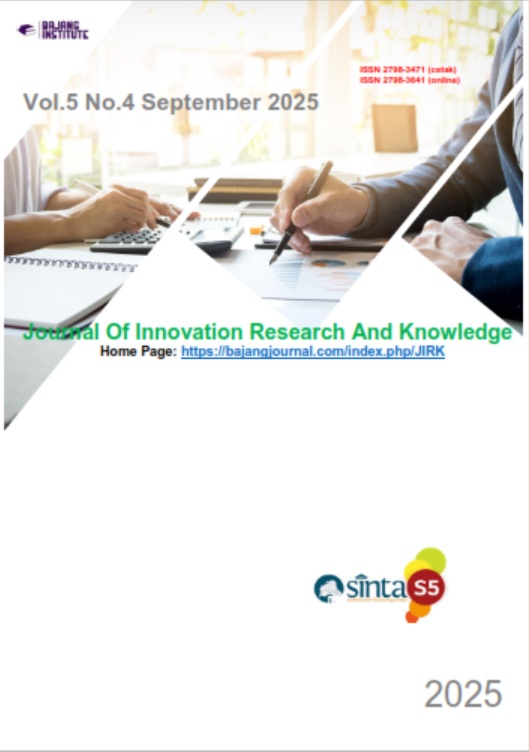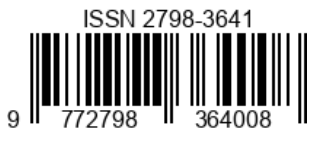EFEKTIVITAS TERAPI BODY SPACE MEDICINE DALAM MENANGANI NYERI PINGGANG KRONIS PADA PASIEN DI GEREJA KRISTEN PROTESTAN SIMALUNGUN (GKPS) PALEMBANG
DOI:
https://doi.org/10.53625/jirk.v5i4.11300Keywords:
Body Space Medicine, Chronic Low Back Pain, Complementary TherapyAbstract
Elmi Hayati / 20230302790548 / 2025 / The Effectiveness of Body Space Medicine Therapy in Managing Chronic Low Back Pain in Patients at the Simalungun Protestant Christian Church / Ir. Hilman Rama Pratama, S.Ud., S.Tr.Kes., M.Pd. Chronic low back pain is a musculoskeletal disorder that often reduces quality of life and productivity. In the ICD-11, Chapter 26 Traditional Medicine (TM1), chronic low back pain is categorized as Lumbago or Yao Tong (腰痛) with the code SC61 Yao Tong. Body Space Medicine (BSM) or Kōngjiān Yīxué is a modern therapeutic method rooted in Traditional Chinese Medicine (TCM) philosophy, emphasizing the balance of body energy through the harmonization of internal spaces. This study aims to determine the effectiveness of BSM therapy in patients with chronic low back pain at GKPS Palembang. The research employed a case study design involving three patients who underwent six sessions of BSM therapy. Evaluations were carried out through anamnesis, tongue observation, vital sign assessment, and patients’ subjective responses. The results showed a decrease in pain intensity, improvement in sleep quality, increased vitality, and positive changes in tongue condition. In conclusion, BSM therapy is effective as a complementary approach to reduce chronic low back pain complaints and improve quality of life.
References
Balagué, F., Mannion, A. F., Pellisé, F., & Cedraschi, C. (2012). Non-specific low back pain. The Lancet, 379(9814), 482–491. https://doi.org/10.1016/S0140-6736(11)60610-7
Bensky, D., Clavey, S., & Stöger, E. (2009). Chinese herbal medicine: Materia medica (3rd ed.). Seattle: Eastland Press.
Catic, A., et al. (2018). [Artikel tentang TCM dan pengaruh musim serta lingkungan geografis].
Chen, J., & Chen, T. (2004). Chinese medical herbology and pharmacology. City of Industry, CA: Art of Medicine Press.
Chou, R., Qaseem, A., Snow, V., Casey, D., Cross, J. T., Shekelle, P., & Owens, D. K. (2007). Diagnosis and treatment of low back pain: A joint clinical practice guideline. Annals of Internal Medicine, 147(7), 478–491.
Cleveland Clinic. (2023). Compression therapy. Cleveland Clinic. https://my.clevelandclinic.org/health/treatments/23449-compression-therapy
Damstra, R. J., & Partsch, H. (2013). Prospective, randomized, controlled trial comparing the effectiveness of adjustable compression Velcro wraps versus inelastic multicomponent compression bandages in the initial treatment of leg lymphedema. Journal of Vascular Surgery: Venous and Lymphatic Disorders, 1(1), 13–19. https://doi.org/10.1016/j.jvsv.2012.05.002
Deyo, R. A., & Weinstein, J. N. (2001). Low back pain. The New England Journal of Medicine, 344(5), 363–370.
Flaws, B. (2005). A handbook of traditional Chinese gynecology. Boulder: Blue Poppy Press.
Gui DK. (2016). Chapter XIII, Section 14: Lumbar pain. In: Wang XH (ed) Textbook of Traditional Chinese Medicine. Science Publisher, Beijing. p. 353.
Guo, Z. C. (2005). Body Space Medicine: Energy, Matter, and Information. Beijing: China Press of Traditional Chinese Medicine.
Guo, Z. C. (2010). Body Space Medicine: Clinical applications and theory. Beijing: China Press of TCM.
Guo, Z. C. (2017). Dong Yi Gong and healing affirmations. Beijing: China Press of TCM.
Hidayati, T. (2009). Faktor risiko nyeri punggung bawah pada pekerja. Jurnal Kesehatan Masyarakat, 4(2), 65–72.
International Labour Organization. (2020). Musculoskeletal disorders and the workplace. Geneva: ILO.
Koes, B. W., van Tulder, M. W., & Thomas, S. (2006). Diagnosis and treatment of low back pain. BMJ, 332(7555), 1430–1434.
Lin, J. G., & Hsu, Y. C. (2014). Integration of traditional Chinese medicine into evidence-based medicine. Journal of Traditional and Complementary Medicine, 4(4), 249–250.
Liu, X., Zhang, Y., & Wang, L. (2020). Clinical study on pestle needle combined with Six Healing Sounds Qi Gong in lumbar disc herniation. Chinese Journal of Traditional Medicine, 45(3), 112–118.
Loretz, L. (2005). Pain assessment and numeric rating scale. Journal of Pain Nursing, 6(1), 10–15.
Maciocia, G. (2015). The foundations of Chinese medicine: A comprehensive text for acupuncturists and herbalists (3rd ed.). London: Elsevier Churchill Livingstone.
Ma HX, Ma D, Lin B, Zheng JX. A meta-analysis on the clinical efficacy of fire dragon cupping in the treatment of lumbar disc herniation. Integr Med Discov. 2024;3:e24011. doi:10.53388/IMD202408011.
Mahasih, A. (2019). Nyeri punggung bawah dan faktor risikonya. Jurnal Kedokteran dan Kesehatan Indonesia, 10(1), 45–52.
Mu, J., Furlan, A. D., Lam, W. Y., & Lao, L. (2020). Acupuncture for chronic nonspecific low back pain. Cochrane Database of Systematic Reviews, 12(12), CD013814. https://doi.org/10.1002/14651858.CD013814.pub2
O’Meara, S., Cullum, N. A., Nelson, E. A., & Dumville, J. C. (2012). Compression for venous leg ulcers. Cochrane Database of Systematic Reviews, 2012(11), CD000265. https://doi.org/10.1002/14651858.CD000265.pub3
Peilin, S. (2011). Diagnosis in Chinese medicine. Edinburgh: Churchill Livingstone.
Rossi, L. (1992). Occupational factors and low back pain. Scandinavian Journal of Work, Environment & Health, 18(Suppl 2), 59–64.
Saputra, H. (2017). Pemeriksaan diagnosis dalam TCM. Jurnal Pengobatan Tradisional, 5(2), 88–97.
Suwinda, D. (2013). Karakteristik nyeri pinggang pada pekerja dengan faktor risiko ergonomi. Jurnal Kesehatan Kerja, 7(1), 22–29.
Woolf, C. J. (2011). Central sensitization: Implications for the diagnosis and treatment of pain. Pain, 152(3 Suppl), S2–S15.
World Health Organization. (2013). Low back pain fact sheet. Geneva: WHO.
World Health Organization. (2020). Musculoskeletal conditions. Geneva: WHO.
Xutian, S., et al. (2009). Traditional Chinese medicine in China and beyond. Bulletin of the World Health Organization, 87(12), 905–908.
Xutian, S., et al. (2015). Body Space Medicine: A new integrative approach. Journal of Integrative Medicine, 13(5), 293–301.













